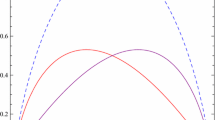Abstract
The Z-number theory is a new concept in fuzzy logic. This theory describes the uncertainty of information where any Z-number is displayed by a pair of fuzzy numbers. The first component of the Z-number creates a restriction on the uncertain variable through a fuzzy number, while the second component of the Z-number explains the reliability of the first component through another fuzzy number. Because there is no any accurate image of the future of financial markets, the Z-number theory can be widely used in the financial markets widely. In this paper, the theory of Z-number is investigated in portfolio selection problem using the utility function. The Z-number is almost always converted to classical fuzzy number in the existing literature. Although this approach reduces the computational complexity, converting Z-number to classical fuzzy number causes the loss of significant information. Hence, we propose two practical models with Z-number approach and optimize them both with and without converting Z-number to classical fuzzy number. Optimization without converting Z-number causes the information about utility of assets and their reliability to be available in each stage. However, optimization with converting Z-number causes portfolio selection model to be transformed into a linear programming model. Furthermore, a practical method for obtaining the utility of assets in shape of the Z-numbers is introduced. In addition, liquidity constraint and the maximal fraction of the capital allocated constraint are considered in portfolio selection models. Eventually, two numerical examples from NYSE and NASDAQ Stock Market are provided, and the results are compared with each other.


Similar content being viewed by others
References
Zadeh, L.A.: A note on Z-numbers. Inf. Sci. 181(14), 2923–2932 (2011)
Kang, B., Wei, D., Li, Y., Deng, Y.: A method of converting Z-number to classical fuzzy number. J Inf. Comput. Sci. 9(3), 703–709 (2012)
Kang, B., Wei, D., Li, Y., Deng, Y.: Decision making using Z-numbers under uncertain environment. J. Comput. Inf. Syst. 8(7), 2807–2814 (2012)
Azadeh, A., Saberi, M., Atashbar, N.Z., Chang, E.J., Pazhoheshfar, P.: Z-AHP: a Z-number extension of fuzzy analytical hierarchy process. In: 7th IEEE International Conference on Digital Ecosystems and Technologies (DEST), pp. 141–147 (2013)
Pal, S.K., Banerjee, R., Dutta, S., Sarma, S.S.: An insight into the Z-number approach to CWW. Fundam. Inf. 124(1–2), 197–229 (2013)
Sadi-Nezhad, S., Sotoudeh-Anvari, A.: A new data envelopment analysis under uncertain environment with respect to fuzziness and an estimation of reliability. OPSEARCH 53, 103–115 (2016)
Azadeh, A., Kokabi, R.: Z-number DEA: a new possibilistic DEA in the context of Z-numbers. Adv. Eng. Inform. 30(3), 604–617 (2016)
Aliev, R.A., Zeinalova, L.M.: Decision making under Z-information. In: Guo, P., Pedrycz, W. (eds.) Human-Centric Decision-Making Models for Social Sciences, Studies in Computational Intelligence, vol. 502, pp. 233–252. Springer, Berlin (2014)
Aliev, R.A., Alizadeh, A.V., Huseynov, O.H., Jabbarova, K.I.: Z-number-based linear programming. Int. J. Intell. Syst. 30(5), 563–589 (2015)
Kumar, A., Singh, P., Kaur, J.: Generalized simplex algorithm to solve fuzzy linear programming problems with ranking of generalized fuzzy numbers. Turk. J. Fuzzy Syst. 1(2), 80–103 (2010)
Zimmermann, H.J.: Fuzzy programming and linear programming with several objective functions. Fuzzy Sets Syst. 1(1), 45–55 (1978)
Delgado, M., Verdegay, J.L., Vila, M.A.: A general model for fuzzy linear programming. Fuzzy Sets Syst. 29(1), 21–29 (1989)
Inuiguchi, M., Ichihashi, H., Kume, Y.: A solution algorithm for fuzzy linear programming with piecewise linear membership functions. Fuzzy Sets Syst. 34(1), 15–31 (1990)
Ramík, J.: Duality in fuzzy linear programming: some new concepts and results. Fuzzy Optim. Decis. Mak. 4(1), 25–39 (2005)
Rommelfanger, H.: A general concept for solving linear multicriteria programming problems with crisp, fuzzy or stochastic values. Fuzzy Sets Syst. 158(17), 1892–1904 (2007)
Dempe, S., Ruziyeva, A.: On the calculation of a membership function for the solution of a fuzzy linear optimization problem. Fuzzy Sets Syst. 188(1), 58–67 (2012)
Luhandjula, M.K., Rangoaga, M.J.: An approach for solving a fuzzy multiobjective programming problem. Eur. J. Oper. Res. 232(2), 249–255 (2014)
Markowitz, H.: Portfolio selection. J. Finance 7(1), 77–91 (1952)
Markowitz, H.: Foundations of portfolio theory. J. Finance 46(2), 469–477 (1991)
Konno, H., Yamazaki, H.: Mean-absolute deviation portfolio optimization model and its applications to Tokyo stock market. Manag. Sci. 37(5), 519–531 (1991)
Speranza, M.G.: Linear programming models for portfolio optimization. Finance 14, 107–123 (1993)
Gupta, P., Inuiguchi, M., Mehlawat, M.K., Mittal, G.: Multiobjective credibilistic portfolio selection model with fuzzy chance-constraints. Inf. Sci. 229, 1–17 (2013)
Najafi, A.A., Pourahmadi, Z.: An efficient heuristic method for dynamic portfolio selection problem under transaction costs and uncertain conditions. Physica A 448, 154–162 (2016)
Huang, X.: Mean-semivariance models for fuzzy portfolio selection. J. Comput. Appl. Math. 217(1), 1–8 (2008)
Liu, S.T.: A fuzzy modeling for fuzzy portfolio optimization. Expert Syst. Appl. 38(11), 13803–13809 (2011)
Ghahtarani, A.R., Najafi, A.A.: A fuzzy approach to mean-CDaR portfolio optimization. Int. J. Appl. Oper. Res. 3(3), 95–104 (2013)
Liu, Y.J., Zhang, W.G.: A multi-period fuzzy portfolio optimization model with minimum transaction lots. Eur. J. Oper. Res. 242(3), 933–941 (2015)
Jirofti, A., Najafi, A.A.: Investment portfolio optimization using value at risk under credibility theory with Z-numbers approach. Financ. Eng. Secur. Manag. 8(30), 95–113 (2017). (In Farsi)
Zadeh, L.A.: The concept of a linguistic variable and its application to approximate reasoning—II. Inf. Sci. 8(4), 301–357 (1975)
Chen, S.M., Chen, J.H.: Fuzzy risk analysis based on ranking generalized fuzzy numbers with different heights and different spreads. Expert Syst. Appl. 36(3), 6833–6842 (2009)
Liu, B., Liu, Y.K.: Expected value of fuzzy variable and fuzzy expected value models. IEEE Trans. Fuzzy Syst. 10, 445–450 (2002)
Author information
Authors and Affiliations
Corresponding author
Rights and permissions
About this article
Cite this article
Jirofti, A., Najafi, A.A. Portfolio Selection Using Z-Number Theory: Two Solution Methodologies. Int. J. Fuzzy Syst. 20, 2484–2496 (2018). https://doi.org/10.1007/s40815-018-0513-4
Received:
Revised:
Accepted:
Published:
Issue Date:
DOI: https://doi.org/10.1007/s40815-018-0513-4




